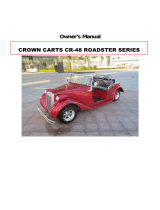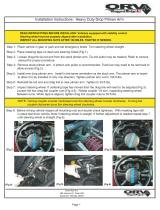
SAFETY RULES AND OPERATING INSTRUCTIONS
Safety Rules
SAFETY RULES AND
GUIDELINES
It is the responsibility of the owner of this vehicle to assure
that the operator understands the various controls and
operating characteristics of this vehicle (extracted from
the American National Standards Institute Personnel and
Burden Carriers ANSI B56.8). As well as, following the
safety rules and guidelines outlined in ANSI B56.8 and
listed below.
These vehicles are designed for driving on smooth
surfaces in and around facilities such as industrial plants,
nurseries, institutions, motels, mobile home parks, and
resorts. They are not to be driven on public highways.
Refer to Vehicle Operational Guidelines, Safety
Guidelines section for important safety information
regarding operating this vehicle.
Read and follow all of the guidelines listed
below. Failure to follow these guidelines
may result in severe bodily injury and/or
property damage.
These vehicles are not designed to be
driven on public roads or highways. They
are available in maximum designed speeds
ranging from 7 to 15 mph. Do not exceed
the maximum designed speed. Exceeding
the maximum designed speed may result
in steering difficulty, motor damage, and/
or loss of control. Do not exceed locally
imposed speed limits. Do not tow this
vehicle at more than 5 mph.
Before working
on a vehicle:
1. Make sure the key-switch is in the “OFF”
position, then remove the key.
2. Place the forward-reverse switch in the
center “OFF” position.
3. Set the park brake.
4. Place blocks under the front wheels to
prevent vehicle movement.
5. Disconnect the main positive and
negative cables at the batteries.
DRIVER TRAINING PROGRAM
According to ANSI B56.8, the owner of this vehicle shall
conduct an Operator Training program for all those who
will be operating this vehicle. The training program shall
not be condensed for those claiming to have previous
vehicle operation experience. Successful completion of
the Operator Training program shall be required for all
personnel who operate this vehicle.
The Operator Training program shall include the
following:
• Operation of this vehicle under circumstances
normally associated with your particular environment.
• Emphasis on the safety of cargo and personnel.
• All safety rules contained within this manual.
• Proper operation of all vehicle controls.
• A vehicle operation and driving test.
Driver Qualifications.
Only those who have successfully completed the
Operator Training program are authorized to drive this
vehicle. Operators must possess the visual, auditory,
physical, and mental ability to safely operate this vehicle
as specified in the American National Standards Institute
Controlled Personnel and Burden Carriers ANSI B56.8.
The following are minimum requirements necessary to
qualify as an operator of this vehicle:
• Demonstrate a working knowledge of each control.
• Understand all safety rules and guidelines as
presented in this manual.
• Know how to properly load and unload cargo.
• Know how to properly park this vehicle.
• Recognize an improperly maintained vehicle.
• Demonstrate ability to handle this vehicle in all
conditions.
























